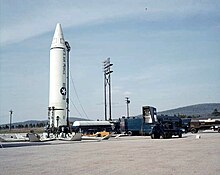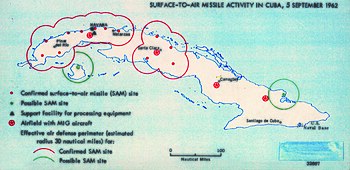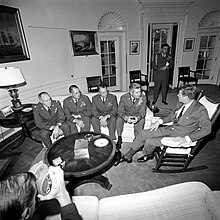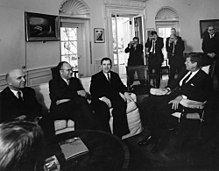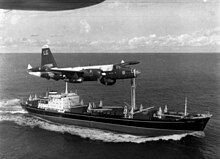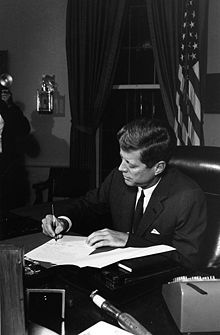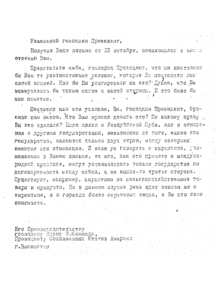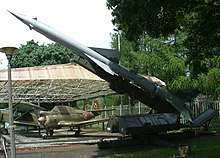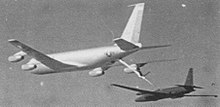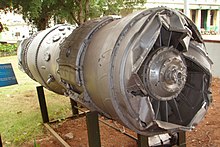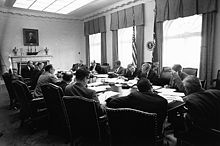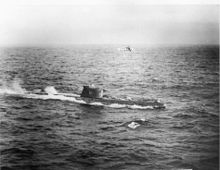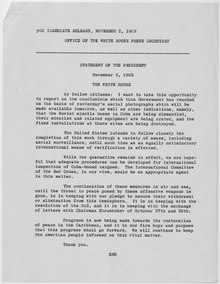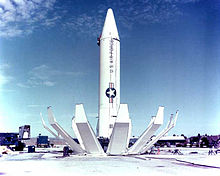| Cuban Missile Crisis | |||||||
|---|---|---|---|---|---|---|---|
| Part of the Cold War | |||||||
 CIA reference photograph of a Soviet medium-range ballistic missile in Red Square, Moscow | |||||||
| |||||||
| Belligerents | |||||||
|
Supported by: |
Supported by: | ||||||
| Commanders and leaders | |||||||
| Casualties and losses | |||||||
| None |
1 U-2 spy aircraft lost 1 killed | ||||||
The Cuban Missile Crisis, also known as the October Crisis of 1962 (Spanish: Crisis de Octubre), the Caribbean Crisis (Russian: Карибский кризис, tr. Karibsky krizis, IPA: [kɐˈrʲipskʲɪj ˈkrʲizʲɪs]), or the Missile Scare, was a 1 month, 4 day (16 October – 20 November 1962) confrontation between the United States and the Soviet Union which escalated into an international crisis when American deployments of missiles in Italy and Turkey were matched by Soviet deployments of similar ballistic missiles in Cuba. Despite the short time frame, the Cuban Missile Crisis remains a defining moment in U.S. national security and nuclear war preparation. The confrontation is often considered the closest the Cold War came to escalating into a full-scale nuclear war.
In response to the presence of American Jupiter ballistic missiles in Italy and Turkey, and the failed Bay of Pigs Invasion of 1961, Soviet First Secretary Nikita Khrushchev agreed to Cuba's request to place nuclear missiles on the island to deter a future invasion. An agreement was reached during a secret meeting between Khrushchev and Cuban Prime Minister Fidel Castro in July 1962, and construction of a number of missile launch facilities started later that summer.
Meanwhile, the 1962 United States elections were under way, and the White House denied charges for months that it was ignoring dangerous Soviet missiles 90 mi (140 km) from Florida. The missile preparations were confirmed when an Air Force U-2 spy plane produced clear photographic evidence of medium-range R-12 (NATO code name SS-4) and intermediate-range R-14 (NATO code name SS-5) ballistic missile facilities.
When this was reported to President John F. Kennedy, he then convened a meeting of the nine members of the National Security Council and five other key advisers in a group that became known as the Executive Committee of the National Security Council (EXCOMM). During this meeting, President Kennedy was originally advised to carry out an air strike on Cuban soil in order to compromise Soviet missile supplies, followed by an invasion of the Cuban mainland. After careful consideration, President Kennedy chose a less aggressive course of action to avoid a declaration of war. After consultation with them, Kennedy ordered a naval "quarantine" on October 22 to prevent further missiles from reaching Cuba. By declaring a quarantine rather than a blockade, the United States was able to avoid a further conflict. This quarantine fell short of a traditional blockade and so avoided the implications of a state of war. The US announced it would not permit offensive weapons to be delivered to Cuba and demanded that the weapons already in Cuba be dismantled and returned to the Soviet Union.
After several days of tense negotiations, an agreement was reached between Kennedy and Khrushchev. Publicly, the Soviets would dismantle their offensive weapons in Cuba and return them to the Soviet Union, subject to United Nations verification, in exchange for a US public declaration and agreement to not invade Cuba again. Secretly, the United States agreed that it would dismantle all of the Jupiter MRBMs, which had been deployed in Turkey against the Soviet Union. There has been debate on whether or not Italy was included in the agreement as well. While the Soviets dismantled their missiles, some Soviet bombers remained in Cuba, forcing the Naval quarantine to stay in place until November 20 of that year.
When all offensive missiles and the Ilyushin Il-28 light bombers had been withdrawn from Cuba, the blockade was formally ended on November 20, 1962. The negotiations between the United States and the Soviet Union pointed out the necessity of a quick, clear, and direct communication line between the two Superpowers. As a result, the Moscow–Washington hotline was established. A series of agreements later reduced US–Soviet tensions for several years until both parties eventually resumed expanding their nuclear arsenals.
Background
Cuba and Berlin Wall
With the end of World War II and the start of the Cold War, the United States had grown concerned about the expansion of communism. A Latin American country openly allying with the Soviet Union was regarded by the US as unacceptable. It would, for example, defy the Monroe Doctrine, a US policy limiting US involvement in European colonies and European affairs but holding that the Western Hemisphere was in the US sphere of influence.
The Kennedy administration had been publicly embarrassed by the failed Bay of Pigs Invasion in April 1961, which had been launched under President John F. Kennedy by CIA-trained forces of Cuban exiles. Afterward, former President Dwight Eisenhower told Kennedy that "the failure of the Bay of Pigs will embolden the Soviets to do something that they would otherwise not do." The half-hearted invasion left Soviet first secretary Nikita Khrushchev and his advisers with the impression that Kennedy was indecisive and, as one Soviet adviser wrote, "too young, intellectual, not prepared well for decision making in crisis situations... too intelligent and too weak". US covert operations against Cuba continued in 1961 with the unsuccessful Operation Mongoose.
In addition, Khrushchev's impression of Kennedy's weaknesses was confirmed by the President's response during the Berlin Crisis of 1961, particularly to the building of the Berlin Wall. Speaking to Soviet officials in the aftermath of the crisis, Khrushchev asserted, "I know for certain that Kennedy doesn't have a strong background, nor, generally speaking, does he have the courage to stand up to a serious challenge." He also told his son Sergei that on Cuba, Kennedy "would make a fuss, make more of a fuss, and then agree".
In January 1962, US Army General Edward Lansdale described plans to overthrow the Cuban government in a top-secret report (partially declassified 1989), addressed to Kennedy and officials involved with Operation Mongoose. CIA agents or "pathfinders" from the Special Activities Division were to be infiltrated into Cuba to carry out sabotage and organization, including radio broadcasts. In February 1962, the US launched an embargo against Cuba, and Lansdale presented a 26-page, top-secret timetable for implementation of the overthrow of the Cuban government, mandating guerrilla operations to begin in August and September. "Open revolt and overthrow of the Communist regime" would occur in the first two weeks of October.
Missile gap
When Kennedy ran for president in 1960, one of his key election issues was an alleged "missile gap" with the Soviets leading. Actually, the US at that time led the Soviets by a wide margin that would only increase. In 1961, the Soviets had only four intercontinental ballistic missiles (R-7 Semyorka). By October 1962, they may have had a few dozen, with some intelligence estimates as high as 75.
The US, on the other hand, had 170 ICBMs and was quickly building more. It also had eight George Washington- and Ethan Allen-class ballistic missile submarines, with the capability to launch 16 Polaris missiles, each with a range of 2,500 nautical miles (4,600 km). Khrushchev increased the perception of a missile gap when he loudly boasted to the world that the Soviets were building missiles "like sausages" but Soviet missiles' numbers and capabilities were nowhere close to his assertions. The Soviet Union had medium-range ballistic missiles in quantity, about 700 of them, but they were very unreliable and inaccurate. The US had a considerable advantage in total number of nuclear warheads (27,000 against 3,600) and in the technology required for their accurate delivery. The US also led in missile defensive capabilities, naval and air power; but the Soviets had a 2–1 advantage in conventional ground forces, more pronounced in field guns and tanks, particularly in the European theatre.
Soviet deployment of missiles in Cuba
Justification
In May 1962, Soviet First Secretary Nikita Khrushchev was persuaded by the idea of countering the US's growing lead in developing and deploying strategic missiles by placing Soviet intermediate-range nuclear missiles in Cuba, despite the misgivings of the Soviet Ambassador in Havana, Alexandr Ivanovich Alexeyev, who argued that Castro would not accept the deployment of the missiles. Khrushchev faced a strategic situation in which the US was perceived to have a "splendid first strike" capability that put the Soviet Union at a huge disadvantage. In 1962, the Soviets had only 20 ICBMs capable of delivering nuclear warheads to the US from inside the Soviet Union. The poor accuracy and reliability of the missiles raised serious doubts about their effectiveness. A newer, more reliable generation of ICBMs would become operational only after 1965.
Therefore, Soviet nuclear capability in 1962 placed less emphasis on ICBMs than on medium and intermediate-range ballistic missiles (MRBMs and IRBMs). The missiles could hit American allies and most of Alaska from Soviet territory but not the Contiguous United States. Graham Allison, the director of Harvard University's Belfer Center for Science and International Affairs, points out, "The Soviet Union could not right the nuclear imbalance by deploying new ICBMs on its own soil. In order to meet the threat it faced in 1962, 1963, and 1964, it had very few options. Moving existing nuclear weapons to locations from which they could reach American targets was one."
A second reason that Soviet missiles were deployed to Cuba was because Khrushchev wanted to bring West Berlin, controlled by the American, British and French within Communist East Germany, into the Soviet orbit. The East Germans and Soviets considered western control over a portion of Berlin a grave threat to East Germany. Khrushchev made West Berlin the central battlefield of the Cold War. Khrushchev believed that if the US did nothing over the missile deployments in Cuba, he could muscle the West out of Berlin using said missiles as a deterrent to western countermeasures in Berlin. If the US tried to bargain with the Soviets after it became aware of the missiles, Khrushchev could demand trading the missiles for West Berlin. Since Berlin was strategically more important than Cuba, the trade would be a win for Khrushchev, as Kennedy recognised: "The advantage is, from Khrushchev's point of view, he takes a great chance but there are quite some rewards to it."
Thirdly, from the perspective of the Soviet Union and of Cuba, it seemed that the United States wanted to increase its presence in Cuba. With actions including the attempt to expel Cuba from the Organization of American States, placing economic sanctions on the nation, directly invading it in addition to conducting secret operations on containing communism and Cuba, it was assumed that America was trying to overrun Cuba. As a result, to try and prevent this, the USSR would place missiles in Cuba and neutralise the threat. This would ultimately serve to secure Cuba against attack and keep the country in the Socialist Bloc.
Another major reason why Khrushchev planned to place missiles on Cuba undetected was to "level the playing field" with the evident American nuclear threat. America had the upper hand as they could launch from Turkey and destroy the USSR before they would have a chance to react. After the transmission of nuclear missiles, Khrushchev had finally established mutually assured destruction, meaning that if the U.S. decided to launch a nuclear strike against the USSR, the latter would react by launching a retaliatory nuclear strike against the U.S.
Finally, placing nuclear missiles on Cuba was a way for the USSR to show their support for Cuba and support the Cuban people who viewed the United States as a threatening force, as the latter had become their ally after the Cuban Revolution of 1959. According to Khrushchev, the Soviet Union's motives were "aimed at allowing Cuba to live peacefully and develop as its people desire".
Deployment
In early 1962, a group of Soviet military and missile construction specialists accompanied an agricultural delegation to Havana. They obtained a meeting with Cuban prime minister Fidel Castro. The Cuban leadership had a strong expectation that the US would invade Cuba again and enthusiastically approved the idea of installing nuclear missiles in Cuba. According to another source, Castro objected to the missiles' deployment as making him look like a Soviet puppet, but he was persuaded that missiles in Cuba would be an irritant to the US and help the interests of the entire socialist camp. Also, the deployment would include short-range tactical weapons (with a range of 40 km, usable only against naval vessels) that would provide a "nuclear umbrella" for attacks upon the island.
By May, Khrushchev and Castro agreed to place strategic nuclear missiles secretly in Cuba. Like Castro, Khrushchev felt that a US invasion of Cuba was imminent and that to lose Cuba would do great harm to the communists, especially in Latin America. He said he wanted to confront the Americans "with more than words.... the logical answer was missiles". The Soviets maintained their tight secrecy, writing their plans longhand, which were approved by Marshal of the Soviet Union Rodion Malinovsky on July 4 and Khrushchev on July 7.
From the very beginning, the Soviets' operation entailed elaborate denial and deception, known as "maskirovka". All the planning and preparation for transporting and deploying the missiles were carried out in the utmost secrecy, with only a very few told the exact nature of the mission. Even the troops detailed for the mission were given misdirection by being told that they were headed for a cold region and being outfitted with ski boots, fleece-lined parkas, and other winter equipment. The Soviet code-name was Operation Anadyr. The Anadyr River flows into the Bering Sea, and Anadyr is also the capital of Chukotsky District and a bomber base in the far eastern region. All the measures were meant to conceal the program from both internal and external audiences.
Specialists in missile construction under the guise of "machine operators", "irrigation specialists", and "agricultural specialists" arrived in July. A total of 43,000 foreign troops would ultimately be brought in. Chief Marshal of Artillery Sergei Biryuzov, Head of the Soviet Rocket Forces, led a survey team that visited Cuba. He told Khrushchev that the missiles would be concealed and camouflaged by palm trees.
The Cuban leadership was further upset when on September 20, the US Senate approved Joint Resolution 230, which expressed the US was determined "to prevent in Cuba the creation or use of an externally-supported military capability endangering the security of the United States". On the same day, the US announced a major military exercise in the Caribbean, PHIBRIGLEX-62, which Cuba denounced as a deliberate provocation and proof that the US planned to invade Cuba.
The Soviet leadership believed, based on its perception of Kennedy's lack of confidence during the Bay of Pigs Invasion, that he would avoid confrontation and accept the missiles as a fait accompli. On September 11, the Soviet Union publicly warned that a US attack on Cuba or on Soviet ships that were carrying supplies to the island would mean war. The Soviets continued the Maskirovka program to conceal their actions in Cuba. They repeatedly denied that the weapons being brought into Cuba were offensive in nature. On September 7, Soviet Ambassador to the United States Anatoly Dobrynin assured United States Ambassador to the United Nations Adlai Stevenson that the Soviet Union was supplying only defensive weapons to Cuba. On September 11, the Telegraph Agency of the Soviet Union (TASS: Telegrafnoe Agentstvo Sovetskogo Soyuza) announced that the Soviet Union had no need or intention to introduce offensive nuclear missiles into Cuba. On October 13, Dobrynin was questioned by former Undersecretary of State Chester Bowles about whether the Soviets planned to put offensive weapons in Cuba. He denied any such plans. On October 17, Soviet embassy official Georgy Bolshakov brought President Kennedy a personal message from Khrushchev reassuring him that "under no circumstances would surface-to-surface missiles be sent to Cuba."
As early as August 1962, the US suspected the Soviets of building missile facilities in Cuba. During that month, its intelligence services gathered information about sightings by ground observers of Russian-built MiG-21 fighters and Il-28 light bombers. U-2 spy planes found S-75 Dvina (NATO designation SA-2) surface-to-air missile sites at eight different locations. CIA director John A. McCone was suspicious. Sending antiaircraft missiles into Cuba, he reasoned, "made sense only if Moscow intended to use them to shield a base for ballistic missiles aimed at the United States". On August 10, he wrote a memo to Kennedy in which he guessed that the Soviets were preparing to introduce ballistic missiles into Cuba.
With important Congressional elections scheduled for November, the crisis became enmeshed in American politics. On August 31, Senator Kenneth Keating (R-New York) warned on the Senate floor that the Soviet Union was "in all probability" constructing a missile base in Cuba. He charged the Kennedy administration with covering up a major threat to the US, thereby starting the crisis. He may have received this initial "remarkably accurate" information from his friend, former congresswoman and ambassador Clare Boothe Luce, who in turn received it from Cuban exiles. A later confirming source for Keating's information possibly was the West German ambassador to Cuba, who had received information from dissidents inside Cuba that Soviet troops had arrived in Cuba in early August and were seen working "in all probability on or near a missile base" and who passed this information to Keating on a trip to Washington in early October. Air Force General Curtis LeMay presented a pre-invasion bombing plan to Kennedy in September, and spy flights and minor military harassment from US forces at Guantanamo Bay Naval Base were the subject of continual Cuban diplomatic complaints to the US government.
The first consignment of R-12 missiles arrived on the night of September 8, followed by a second on September 16. The R-12 was a medium-range ballistic missile, capable of carrying a thermonuclear warhead. It was a single-stage, road-transportable, surface-launched, storable liquid propellant fuelled missile that could deliver a megaton-class nuclear weapon. The Soviets were building nine sites—six for R-12 medium-range missiles (NATO designation SS-4 Sandal) with an effective range of 2,000 kilometres (1,200 mi) and three for R-14 intermediate-range ballistic missiles (NATO designation SS-5 Skean) with a maximum range of 4,500 kilometres (2,800 mi).
On October 7, Cuban President Osvaldo Dorticós Torrado spoke at the UN General Assembly: "If... we are attacked, we will defend ourselves. I repeat, we have sufficient means with which to defend ourselves; we have indeed our inevitable weapons, the weapons, which we would have preferred not to acquire, and which we do not wish to employ." On October 10 in another Senate speech Sen. Keating reaffirmed his earlier warning of August 31 and stated that, "Construction has begun on at least a half dozen launching sites for intermediate range tactical missiles."
Missiles reported
The missiles in Cuba allowed the Soviets to effectively target most of the Continental US. The planned arsenal was forty launchers. The Cuban populace readily noticed the arrival and deployment of the missiles and hundreds of reports reached Miami. US intelligence received countless reports, many of dubious quality or even laughable, most of which could be dismissed as describing defensive missiles.
Only five reports bothered the analysts. They described large trucks passing through towns at night that were carrying very long canvas-covered cylindrical objects that could not make turns through towns without backing up and manoeuvring. Defensive missiles could turn. The reports could not be satisfactorily dismissed.
Aerial confirmation
The United States had been sending U-2 surveillance over Cuba since the failed Bay of Pigs Invasion. The first issue that led to a pause in reconnaissance flights took place on August 30, when a U-2 operated by the US Air Force's Strategic Air Command flew over Sakhalin Island in the Soviet Far East by mistake. The Soviets lodged a protest and the US apologised. Nine days later, a Taiwanese-operated U-2 was lost over western China to an SA-2 surface-to-air missile. US officials were worried that one of the Cuban or Soviet SAMs in Cuba might shoot down a CIA U-2, initiating another international incident. In a meeting with members of the Committee on Overhead Reconnaissance (COMOR) on September 10, Secretary of State Dean Rusk and National Security Advisor McGeorge Bundy heavily restricted further U-2 flights over Cuban airspace. The resulting lack of coverage over the island for the next five weeks became known to historians as the "Photo Gap". No significant U-2 coverage was achieved over the interior of the island. US officials attempted to use a Corona photo-reconnaissance satellite to obtain coverage over reported Soviet military deployments, but imagery acquired over western Cuba by a Corona KH-4 mission on October 1 was heavily covered by clouds and haze and failed to provide any usable intelligence. At the end of September, Navy reconnaissance aircraft photographed the Soviet ship Kasimov, with large crates on its deck the size and shape of Il-28 jet bomber fuselages.
In September 1962, analysts from the Defense Intelligence Agency (DIA) noticed that Cuban surface-to-air missile sites were arranged in a pattern similar to those used by the Soviet Union to protect its ICBM bases, leading DIA to lobby for the resumption of U-2 flights over the island. Although in the past the flights had been conducted by the CIA, pressure from the Defense Department led to that authority being transferred to the Air Force. Following the loss of a CIA U-2 over the Soviet Union in May 1960, it was thought that if another U-2 were shot down, an Air Force aircraft arguably being used for a legitimate military purpose would be easier to explain than a CIA flight.
When the reconnaissance missions were reauthorized on October 9, poor weather kept the planes from flying. The US first obtained U-2 photographic evidence of the missiles on October 14, when a U-2 flight piloted by Major Richard Heyser took 928 pictures on a path selected by DIA analysts, capturing images of what turned out to be an SS-4 construction site at San Cristóbal, Pinar del Río Province (now in Artemisa Province), in western Cuba.
President notified
On October 15, the CIA's National Photographic Interpretation Center (NPIC) reviewed the U-2 photographs and identified objects that they interpreted as medium range ballistic missiles. This identification was made, in part, on the strength of reporting provided by Oleg Penkovsky, a double agent in the GRU working for the CIA and MI6. Although he provided no direct reports of the Soviet missile deployments to Cuba, technical and doctrinal details of Soviet missile regiments that had been provided by Penkovsky in the months and years prior to the Crisis helped NPIC analysts correctly identify the missiles on U-2 imagery.
That evening, the CIA notified the Department of State and at 8:30 pm EDT, Bundy chose to wait until the next morning to tell the President. McNamara was briefed at midnight. The next morning, Bundy met with Kennedy and showed him the U-2 photographs and briefed him on the CIA's analysis of the images. At 6:30 pm EDT, Kennedy convened a meeting of the nine members of the National Security Council and five other key advisers, in a group he formally named the Executive Committee of the National Security Council (EXCOMM) after the fact on October 22 by the National Security Action Memorandum 196. Without informing the members of EXCOMM, President Kennedy tape recorded all of their proceedings, and Sheldon M. Stern, head of the Kennedy library transcribed some of them.
On October 16, President Kennedy notified Robert Kennedy that he was convinced Russia was placing missiles in Cuba and it was a legitimate threat. This officially made the threat of nuclear destruction by two world superpowers a reality. Robert Kennedy responded by contacting the Soviet Ambassador, Anatoly Dobrynin. Robert Kennedy expressed his "concern about what was happening" and Dobrynin "was instructed by Soviet Chairman Nikita S. Khrushchev to assure President Kennedy that there would be no ground-to-ground missiles or offensive weapons placed in Cuba". Khrushchev further assured Kennedy that the Soviet Union had no intention of "disrupting the relationship of our two countries" despite the photo evidence presented before President Kennedy.
Responses considered
The US had no plan in place because its intelligence had been convinced that the Soviets would never install nuclear missiles in Cuba. EXCOMM, of which Vice President Lyndon B. Johnson was a member, quickly discussed several possible courses of action:
- Do nothing: American vulnerability to Soviet missiles was not new.
- Diplomacy: Use diplomatic pressure to get the Soviet Union to remove the missiles.
- Secret approach: Offer Castro the choice of splitting with the Russians or being invaded.
- Invasion: Full force invasion of Cuba and overthrow of Castro.
- Air strike: Use the US Air Force to attack all known missile sites.
- Blockade: Use the US Navy to block any missiles from arriving in Cuba.
The Joint Chiefs of Staff unanimously agreed that a full-scale attack and invasion was the only solution. They believed that the Soviets would not attempt to stop the US from conquering Cuba. Kennedy was skeptical:
They, no more than we, can let these things go by without doing something. They can't, after all their statements, permit us to take out their missiles, kill a lot of Russians, and then do nothing. If they don't take action in Cuba, they certainly will in Berlin.
Kennedy concluded that attacking Cuba by air would signal the Soviets to presume "a clear line" to conquer Berlin. Kennedy also believed that US allies would think of the country as "trigger-happy cowboys" who lost Berlin because they could not peacefully resolve the Cuban situation.
The EXCOMM then discussed the effect on the strategic balance of power, both political and military. The Joint Chiefs of Staff believed that the missiles would seriously alter the military balance, but McNamara disagreed. An extra 40, he reasoned, would make little difference to the overall strategic balance. The US already had approximately 5,000 strategic warheads, but the Soviet Union had only 300. McNamara concluded that the Soviets having 340 would not therefore substantially alter the strategic balance. In 1990, he reiterated that "it made no difference.... The military balance wasn't changed. I didn't believe it then, and I don't believe it now."
The EXCOMM agreed that the missiles would affect the political balance. Kennedy had explicitly promised the American people less than a month before the crisis that "if Cuba should possess a capacity to carry out offensive actions against the United States... the United States would act." Also, credibility among US allies and people would be damaged if the Soviet Union appeared to redress the strategic balance by placing missiles in Cuba. Kennedy explained after the crisis that "it would have politically changed the balance of power. It would have appeared to, and appearances contribute to reality."
On October 18, Kennedy met with the Soviet Minister of Foreign Affairs, Andrei Gromyko, who claimed the weapons were for defensive purposes only. Not wanting to expose what he already knew and to avoid panicking the American public, Kennedy did not reveal that he was already aware of the missile buildup. By October 19, frequent U-2 spy flights showed four operational sites.
Operational plans
Two Operational Plans (OPLAN) were considered. OPLAN 316 envisioned a full invasion of Cuba by Army and Marine units, supported by the Navy following Air Force and naval airstrikes. Army units in the US would have had trouble fielding mechanised and logistical assets, and the US Navy could not supply enough amphibious shipping to transport even a modest armoured contingent from the Army.
OPLAN 312, primarily an Air Force and Navy carrier operation, was designed with enough flexibility to do anything from engaging individual missile sites to providing air support for OPLAN 316's ground forces.
Blockade
Kennedy met with members of EXCOMM and other top advisers throughout October 21, considering two remaining options: an air strike primarily against the Cuban missile bases or a naval blockade of Cuba. A full-scale invasion was not the administration's first option. McNamara supported the naval blockade as a strong but limited military action that left the US in control. The term "blockade" was problematic. According to international law, a blockade is an act of war, but the Kennedy administration did not think that the Soviets would be provoked to attack by a mere blockade. Additionally, legal experts at the State Department and Justice Department concluded that a declaration of war could be avoided if another legal justification, based on the Rio Treaty for defence of the Western Hemisphere, was obtained from a resolution by a two-thirds vote from the members of the Organization of American States (OAS).
Admiral Anderson, Chief of Naval Operations wrote a position paper that helped Kennedy to differentiate between what they termed a "quarantine" of offensive weapons and a blockade of all materials, claiming that a classic blockade was not the original intention. Since it would take place in international waters, Kennedy obtained the approval of the OAS for military action under the hemispheric defence provisions of the Rio Treaty:
Latin American participation in the quarantine now involved two Argentine destroyers which were to report to the US Commander South Atlantic [COMSOLANT] at Trinidad on November 9. An Argentine submarine and a Marine battalion with lift were available if required. In addition, two Venezuelan destroyers (Destroyers ARV D-11 Nueva Esparta" and "ARV D-21 Zulia") and one submarine (Caribe) had reported to COMSOLANT, ready for sea by November 2. The Government of Trinidad and Tobago offered the use of Chaguaramas Naval Base to warships of any OAS nation for the duration of the "quarantine". The Dominican Republic had made available one escort ship. Colombia was reported ready to furnish units and had sent military officers to the US to discuss this assistance. The Argentine Air Force informally offered three SA-16 aircraft in addition to forces already committed to the "quarantine" operation.
This initially was to involve a naval blockade against offensive weapons within the framework of the Organization of American States and the Rio Treaty. Such a blockade might be expanded to cover all types of goods and air transport. The action was to be backed up by surveillance of Cuba. The CNO's scenario was followed closely in later implementing the "quarantine."
On October 19, the EXCOMM formed separate working groups to examine the air strike and blockade options, and by the afternoon most support in the EXCOMM shifted to the blockade option. Reservations about the plan continued to be voiced as late as the October 21, the paramount concern being that once the blockade was put into effect, the Soviets would rush to complete some of the missiles. Consequently, the US could find itself bombing operational missiles if the blockade failed to force Khrushchev to remove the missiles already on the island.
Speech to the nation
At 3:00 pm EDT on October 22, President Kennedy formally established the Executive Committee (EXCOMM) with National Security Action Memorandum (NSAM) 196. At 5:00 pm, he met with Congressional leaders who contentiously opposed a blockade and demanded a stronger response. In Moscow, Ambassador Foy D. Kohler briefed Khrushchev on the pending blockade and Kennedy's speech to the nation. Ambassadors around the world gave notice to non-Eastern Bloc leaders. Before the speech, US delegations met with Canadian Prime Minister John Diefenbaker, British Prime Minister Harold Macmillan, West German Chancellor Konrad Adenauer, French President Charles de Gaulle and Secretary-General of the Organization of American States, José Antonio Mora to brief them on the US intelligence and their proposed response. All were supportive of the US position. Over the course of the crisis, Kennedy had daily telephone conversations with Macmillan, who was publicly supportive of US actions.
Shortly before his speech, Kennedy called former President Dwight Eisenhower. Kennedy's conversation with the former president also revealed that the two were consulting during the Cuban Missile Crisis. The two also anticipated that Khrushchev would respond to the Western world in a manner that was similar to his response during the Suez Crisis and would possibly wind up trading off Berlin.
On October 22 at 7:00 pm EDT, Kennedy delivered a nationwide televised address on all of the major networks announcing the discovery of the missiles. He noted:
It shall be the policy of this nation to regard any nuclear missile launched from Cuba against any nation in the Western Hemisphere as an attack by the Soviet Union on the United States, requiring a full retaliatory response upon the Soviet Union.
Kennedy described the administration's plan:
To halt this offensive buildup, a strict quarantine on all offensive military equipment under shipment to Cuba is being initiated. All ships of any kind bound for Cuba, from whatever nation or port, will, if found to contain cargoes of offensive weapons, be turned back. This quarantine will be extended, if needed, to other types of cargo and carriers. We are not at this time, however, denying the necessities of life as the Soviets attempted to do in their Berlin blockade of 1948.
During the speech, a directive went out to all US forces worldwide, placing them on DEFCON 3. The heavy cruiser USS Newport News was designated flagship for the blockade, with USS Leary as Newport News's destroyer escort. Kennedy's speech writer Ted Sorensen stated in 2007 that the address to the nation was "Kennedy's most important speech historically, in terms of its impact on our planet."
Crisis deepens
On October 23, at 11:24 am EDT, a cable, drafted by George Wildman Ball to the US Ambassador in Turkey and NATO, notified them that they were considering making an offer to withdraw what the US knew to be nearly-obsolete missiles from Italy and Turkey, in exchange for the Soviet withdrawal from Cuba. Turkish officials replied that they would "deeply resent" any trade involving the US missile presence in their country. Two days later, on the morning of October 25, American journalist Walter Lippmann proposed the same thing in his syndicated column. Castro reaffirmed Cuba's right to self-defense and said that all of its weapons were defensive and Cuba would not allow an inspection.
International response
Three days after Kennedy's speech, the Chinese People's Daily announced that "650,000,000 Chinese men and women were standing by the Cuban people." In West Germany, newspapers supported the US response by contrasting it with the weak American actions in the region during the preceding months. They also expressed some fear that the Soviets might retaliate in Berlin. In France on October 23, the crisis made the front page of all the daily newspapers. The next day, an editorial in Le Monde expressed doubt about the authenticity of the CIA's photographic evidence. Two days later, after a visit by a high-ranking CIA agent, the newspaper accepted the validity of the photographs. Also in France, in the October 29 issue of Le Figaro, Raymond Aron wrote in support of the American response. On October 24, Pope John XXIII sent a message to the Soviet embassy in Rome to be transmitted to the Kremlin in which he voiced his concern for peace. In this message he stated, "We beg all governments not to remain deaf to this cry of humanity. That they do all that is in their power to save peace."
Soviet broadcast and communications
The crisis was continuing unabated, and in the evening of October 24, the Soviet news agency TASS broadcast a telegram from Khrushchev to Kennedy in which Khrushchev warned that the United States' "outright piracy" would lead to war. That was followed at 9:24 pm by a telegram from Khrushchev to Kennedy, which was received at 10:52 pm EDT. Khrushchev stated, "if you weigh the present situation with a cool head without giving way to passion, you will understand that the Soviet Union cannot afford not to decline the despotic demands of the USA" and that the Soviet Union views the blockade as "an act of aggression" and their ships will be instructed to ignore it. After October 23, Soviet communications with the USA increasingly showed indications of having been rushed. Undoubtedly a product of pressure, it was not uncommon for Khrushchev to repeat himself and send messages lacking simple editing. With President Kennedy making his aggressive intentions of a possible air-strike followed by an invasion on Cuba known, Khrushchev rapidly sought a diplomatic compromise. Communications between the two super-powers had entered into a unique and revolutionary period; with the newly developed threat of mutual destruction through the deployment of nuclear weapons, diplomacy now demonstrated how power and coercion could dominate negotiations.
US alert level raised
The US requested an emergency meeting of the United Nations Security Council on October 25. US Ambassador to the United Nations Adlai Stevenson confronted Soviet Ambassador Valerian Zorin in an emergency meeting of the Security Council, challenging him to admit the existence of the missiles. Ambassador Zorin refused to answer. The next day at 10:00 pm EDT, the US raised the readiness level of SAC forces to DEFCON 2. For the only confirmed time in US history, B-52 bombers went on continuous airborne alert, and B-47 medium bombers were dispersed to various military and civilian airfields and made ready to take off, fully equipped, on 15 minutes' notice. One eighth of SAC's 1,436 bombers were on airborne alert, and some 145 intercontinental ballistic missiles stood on ready alert, some of which targeted Cuba, and Air Defense Command (ADC) redeployed 161 nuclear-armed interceptors to 16 dispersal fields within nine hours, with one third maintaining 15-minute alert status. Twenty-three nuclear-armed B-52s were sent to orbit points within striking distance of the Soviet Union so that it would believe that the US was serious. Jack J. Catton later estimated that about 80 percent of SAC's planes were ready for launch during the crisis; David A. Burchinal recalled that, by contrast:
the Russians were so thoroughly stood down, and we knew it. They didn't make any move. They did not increase their alert; they did not increase any flights, or their air defense posture. They didn't do a thing, they froze in place. We were never further from nuclear war than at the time of Cuba, never further.
By October 22, Tactical Air Command (TAC) had 511 fighters plus supporting tankers and reconnaissance aircraft deployed to face Cuba on one-hour alert status. TAC and the Military Air Transport Service had problems. The concentration of aircraft in Florida strained command and support echelons, which faced critical undermanning in security, armaments, and communications; the absence of initial authorization for war-reserve stocks of conventional munitions forced TAC to scrounge; and the lack of airlift assets to support a major airborne drop necessitated the call-up of 24 Reserve squadrons.
On October 25 at 1:45 am EDT, Kennedy responded to Khrushchev's telegram by stating that the US was forced into action after receiving repeated assurances that no offensive missiles were being placed in Cuba, and when the assurances proved to be false, the deployment "required the responses I have announced.... I hope that your government will take necessary action to permit a restoration of the earlier situation."
Blockade challenged
At 7:15 am EDT on October 25, USS Essex and USS Gearing attempted to intercept Bucharest but failed to do so. Fairly certain that the tanker did not contain any military material, the US allowed it through the blockade. Later that day, at 5:43 pm, the commander of the blockade effort ordered the destroyer USS Joseph P. Kennedy Jr. to intercept and board the Lebanese freighter Marucla. That took place the next day, and Marucla was cleared through the blockade after its cargo was checked.
At 5:00 pm EDT on October 25, William Clements announced that the missiles in Cuba were still actively being worked on. That report was later verified by a CIA report that suggested there had been no slowdown at all. In response, Kennedy issued Security Action Memorandum 199, authorizing the loading of nuclear weapons onto aircraft under the command of SACEUR, which had the duty of carrying out first air strikes on the Soviet Union. Kennedy claimed that the blockade had succeeded when the USSR turned back fourteen ships presumably carrying offensive weapons. The first indication of this came from a report from the British GCHQ sent to the White House Situation Room containing intercepted communications from Soviet ships reporting their positions. On October 24, Kislovodsk, a Soviet cargo ship, reported a position north-east of where it had been 24 hours earlier indicating it had "discontinued" its voyage and turned back towards the Baltic. The next day, reports showed more ships originally bound for Cuba had altered their course.
Raising the stakes
The next morning, October 26, Kennedy informed the EXCOMM that he believed only an invasion would remove the missiles from Cuba. He was persuaded to give the matter time and continue with both military and diplomatic pressure. He agreed and ordered the low-level flights over the island to be increased from two per day to once every two hours. He also ordered a crash program to institute a new civil government in Cuba if an invasion went ahead.
At this point, the crisis was ostensibly at a stalemate. The Soviets had shown no indication that they would back down and had made public media and private inter-governmental statements to that effect. The US had no reason to believe otherwise and was in the early stages of preparing for an invasion, along with a nuclear strike on the Soviet Union if it responded militarily, which was assumed. Kennedy had no intention of keeping these plans a secret; with an array of Cuban and Soviet spies forever present, Khrushchev was quickly made aware of this looming danger.
The implicit threat of air strikes on Cuba followed by invasion allowed the United States to exert pressure in future talks. It was the possibility of military action that played an influential role in accelerating Khrushchev's proposal for a compromise. Throughout the closing stages of October, Soviet communications to the United States indicated increasing defensiveness. Khrushchev's increasing tendency to use poorly phrased and ambiguous communications throughout the compromise negotiations conversely increased United States confidence and clarity in messaging. Leading Soviet figures consistently failed to mention that only the Cuban government could agree to inspections of the territory and continually made arrangements relating to Cuba without the knowledge of Fidel Castro himself. According to Dean Rusk, Khrushchev "blinked", he began to panic from the consequences of his own plan and this was reflected in the tone of Soviet messages. This allowed the US to largely dominate negotiations in late October.
Secret negotiations
At 1:00 pm EDT on October 26, John A. Scali of ABC News had lunch with Aleksandr Fomin, the cover name of Alexander Feklisov, the KGB station chief in Washington, at Fomin's request. Following the instructions of the Politburo of the CPSU, Fomin noted, "War seems about to break out." He asked Scali to use his contacts to talk to his "high-level friends" at the State Department to see if the US would be interested in a diplomatic solution. He suggested that the language of the deal would contain an assurance from the Soviet Union to remove the weapons under UN supervision and that Castro would publicly announce that he would not accept such weapons again in exchange for a public statement by the US that it would not invade Cuba. The US responded by asking the Brazilian government to pass a message to Castro that the US would be "unlikely to invade" if the missiles were removed.
Mr. President, we and you ought not now to pull on the ends of the rope in which you have tied the knot of war, because the more the two of us pull, the tighter that knot will be tied. And a moment may come when that knot will be tied so tight that even he who tied it will not have the strength to untie it, and then it will be necessary to cut that knot, and what that would mean is not for me to explain to you, because you yourself understand perfectly of what terrible forces our countries dispose.
Consequently, if there is no intention to tighten that knot and thereby to doom the world to the catastrophe of thermonuclear war, then let us not only relax the forces pulling on the ends of the rope, let us take measures to untie that knot. We are ready for this.
— Letter From Chairman Khrushchev to President Kennedy, October 26, 1962
On October 26 at 6:00 pm EDT, the State Department started receiving a message that appeared to be written personally by Khrushchev. It was Saturday at 2:00 am in Moscow. The long letter took several minutes to arrive, and it took translators additional time to translate and transcribe it.
Robert F. Kennedy described the letter as "very long and emotional". Khrushchev reiterated the basic outline that had been stated to Scali earlier in the day: "I propose: we, for our part, will declare that our ships bound for Cuba are not carrying any armaments. You will declare that the United States will not invade Cuba with its troops and will not support any other forces which might intend to invade Cuba. Then the necessity of the presence of our military specialists in Cuba will disappear." At 6:45 pm EDT, news of Fomin's offer to Scali was finally heard and was interpreted as a "set up" for the arrival of Khrushchev's letter. The letter was then considered official and accurate although it was later learned that Fomin was almost certainly operating of his own accord without official backing. Additional study of the letter was ordered and continued into the night.
Crisis continues
Direct aggression against Cuba would mean nuclear war. The Americans speak about such aggression as if they did not know or did not want to accept this fact. I have no doubt they would lose such a war.
— Che Guevara, October 1962
Castro, on the other hand, was convinced that an invasion of Cuba was soon at hand, and on October 26, he sent a telegram to Khrushchev that appeared to call for a pre-emptive nuclear strike on the US in case of attack. In a 2010 interview, Castro expressed regret about his earlier stance on first use: "After I've seen what I've seen, and knowing what I know now, it wasn't worth it at all." Castro also ordered all anti-aircraft weapons in Cuba to fire on any US aircraft: the orders had been to fire only on groups of two or more. At 6:00 am EDT on October 27, the CIA delivered a memo reporting that three of the four missile sites at San Cristobal and the two sites at Sagua la Grande appeared to be fully operational. It also noted that the Cuban military continued to organise for action but was under order not to initiate action unless attacked.
At 9:00 am EDT on October 27, Radio Moscow began broadcasting a message from Khrushchev. Contrary to the letter of the night before, the message offered a new trade: the missiles on Cuba would be removed in exchange for the removal of the Jupiter missiles from Italy and Turkey. At 10:00 am EDT, the executive committee met again to discuss the situation and came to the conclusion that the change in the message was because of internal debate between Khrushchev and other party officials in the Kremlin. Kennedy realised that he would be in an "insupportable position if this becomes Khrushchev's proposal" because the missiles in Turkey were not militarily useful and were being removed anyway and "It's gonna – to any man at the United Nations or any other rational man, it will look like a very fair trade." Bundy explained why Khrushchev's public acquiescence could not be considered: "The current threat to peace is not in Turkey, it is in Cuba."
McNamara noted that another tanker, the Grozny, was about 600 miles (970 km) out and should be intercepted. He also noted that they had not made the Soviets aware of the blockade line and suggested relaying that information to them via U Thant at the United Nations.
While the meeting progressed, at 11:03 am EDT a new message began to arrive from Khrushchev. The message stated, in part:
"You are disturbed over Cuba. You say that this disturbs you because it is ninety-nine miles by sea from the coast of the United States of America. But... you have placed destructive missile weapons, which you call offensive, in Italy and Turkey, literally next to us.... I therefore make this proposal: We are willing to remove from Cuba the means which you regard as offensive.... Your representatives will make a declaration to the effect that the United States... will remove its analogous means from Turkey... and after that, persons entrusted by the United Nations Security Council could inspect on the spot the fulfillment of the pledges made."
The executive committee continued to meet through the day.
Throughout the crisis, Turkey had repeatedly stated that it would be upset if the Jupiter missiles were removed. Italy's Prime Minister Amintore Fanfani, who was also Foreign Minister ad interim, offered to allow withdrawal of the missiles deployed in Apulia as a bargaining chip. He gave the message to one of his most trusted friends, Ettore Bernabei, the general manager of RAI-TV, to convey to Arthur M. Schlesinger Jr. Bernabei was in New York to attend an international conference on satellite TV broadcasting. Unknown to the Soviets, the US regarded the Jupiter missiles as obsolete and already supplanted by the Polaris nuclear ballistic submarine missiles.
On the morning of October 27, a U-2F (the third CIA U-2A, modified for air-to-air refuelling) piloted by USAF Major Rudolf Anderson, departed its forward operating location at McCoy AFB, Florida. At approximately 12:00 pm EDT, the aircraft was struck by an SA-2 surface-to-air missile launched from Cuba. The aircraft was shot down, and Anderson was killed. The stress in negotiations between the Soviets and the US intensified; it was only later believed that the decision to fire the missile was made locally by an undetermined Soviet commander, acting on his own authority. Later that day, at about 3:41 pm EDT, several US Navy RF-8A Crusader aircraft, on low-level photo-reconnaissance missions, were fired upon.
On October 28, 1962, Khrushchev told his son Sergei that the shooting down of Anderson's U-2 was by the "Cuban military at the direction of Raul Castro".
At 4:00 pm EDT, Kennedy recalled members of EXCOMM to the White House and ordered that a message should immediately be sent to U Thant asking the Soviets to suspend work on the missiles while negotiations were carried out. During the meeting, General Maxwell Taylor delivered the news that the U-2 had been shot down. Kennedy had earlier claimed he would order an attack on such sites if fired upon, but he decided to not act unless another attack was made. Forty years later, McNamara said:
We had to send a U-2 over to gain reconnaissance information on whether the Soviet missiles were becoming operational. We believed that if the U-2 was shot down that—the Cubans didn't have capabilities to shoot it down, the Soviets did—we believed if it was shot down, it would be shot down by a Soviet surface-to-air-missile unit, and that it would represent a decision by the Soviets to escalate the conflict. And therefore, before we sent the U-2 out, we agreed that if it was shot down we wouldn't meet, we'd simply attack. It was shot down on Friday.... Fortunately, we changed our mind, we thought "Well, it might have been an accident, we won't attack." Later we learned that Khrushchev had reasoned just as we did: we send over the U-2, if it was shot down, he reasoned we would believe it was an intentional escalation. And therefore, he issued orders to Pliyev, the Soviet commander in Cuba, to instruct all of his batteries not to shoot down the U-2.
Ellsberg said that Robert Kennedy (RFK) told him in 1964 that after the U-2 was shot down and the pilot killed, he (RFK) told Soviet ambassador Dobrynin, "You have drawn first blood ... . [T]he president had decided against advice ... not to respond militarily to that attack, but he [Dobrynin] should know that if another plane was shot at, ... we would take out all the SAMs and antiaircraft ... . And that would almost surely be followed by an invasion."
Drafting response
Emissaries sent by both Kennedy and Khrushchev agreed to meet at the Yenching Palace Chinese restaurant in the Cleveland Park neighbourhood of Washington, DC, on Saturday evening, October 27. Kennedy suggested to take Khrushchev's offer to trade away the missiles. Unknown to most members of the EXCOMM, but with the support of his brother the president, Robert Kennedy had been meeting with the Soviet Ambassador Dobrynin in Washington to discover whether the intentions were genuine. The EXCOMM was generally against the proposal because it would undermine NATO's authority, and the Turkish government had repeatedly stated it was against any such trade.
As the meeting progressed, a new plan emerged, and Kennedy was slowly persuaded. The new plan called for him to ignore the latest message and instead to return to Khrushchev's earlier one. Kennedy was initially hesitant, feeling that Khrushchev would no longer accept the deal because a new one had been offered, but Llewellyn Thompson argued that it was still possible. White House Special Counsel and Adviser Ted Sorensen and Robert Kennedy left the meeting and returned 45 minutes later, with a draft letter to that effect. The President made several changes, had it typed, and sent it.
After the EXCOMM meeting, a smaller meeting continued in the Oval Office. The group argued that the letter should be underscored with an oral message to Dobrynin that stated that if the missiles were not withdrawn, military action would be used to remove them. Rusk added one proviso that no part of the language of the deal would mention Turkey, but there would be an understanding that the missiles would be removed "voluntarily" in the immediate aftermath. The president agreed, and the message was sent.
At Rusk's request, Fomin and Scali met again. Scali asked why the two letters from Khrushchev were so different, and Fomin claimed it was because of "poor communications". Scali replied that the claim was not credible and shouted that he thought it was a "stinking double cross". He went on to claim that an invasion was only hours away, and Fomin stated that a response to the US message was expected from Khrushchev shortly and urged Scali to tell the State Department that no treachery was intended. Scali said that he did not think anyone would believe him, but he agreed to deliver the message. The two went their separate ways, and Scali immediately typed out a memo for the EXCOMM.
Within the US establishment, it was well understood that ignoring the second offer and returning to the first put Khrushchev in a terrible position. Military preparations continued, and all active duty Air Force personnel were recalled to their bases for possible action. Robert Kennedy later recalled the mood: "We had not abandoned all hope, but what hope there was now rested with Khrushchev's revising his course within the next few hours. It was a hope, not an expectation. The expectation was military confrontation by Tuesday (October 30), and possibly tomorrow (October 29) ...."
At 8:05 pm EDT, the letter drafted earlier in the day was delivered. The message read, "As I read your letter, the key elements of your proposals—which seem generally acceptable as I understand them—are as follows: 1) You would agree to remove these weapons systems from Cuba under appropriate United Nations observation and supervision; and undertake, with suitable safe-guards, to halt the further introduction of such weapon systems into Cuba. 2) We, on our part, would agree—upon the establishment of adequate arrangements through the United Nations, to ensure the carrying out and continuation of these commitments (a) to remove promptly the quarantine measures now in effect and (b) to give assurances against the invasion of Cuba." The letter was also released directly to the press to ensure it could not be "delayed". With the letter delivered, a deal was on the table. As Robert Kennedy noted, there was little expectation it would be accepted. At 9:00 pm EDT, the EXCOMM met again to review the actions for the following day. Plans were drawn up for air strikes on the missile sites as well as other economic targets, notably petroleum storage. McNamara stated that they had to "have two things ready: a government for Cuba, because we're going to need one; and secondly, plans for how to respond to the Soviet Union in Europe, because sure as hell they're going to do something there".
At 12:12 am EDT, on October 27, the US informed its NATO allies that "the situation is growing shorter.... the United States may find it necessary within a very short time in its interest and that of its fellow nations in the Western Hemisphere to take whatever military action may be necessary." To add to the concern, at 6:00 am, the CIA reported that all missiles in Cuba were ready for action.
On October 27, Khrushchev also received a letter from Castro, what is now known as the Armageddon Letter (dated the day before), which was interpreted as urging the use of nuclear force in the event of an attack on Cuba: "I believe the imperialists' aggressiveness is extremely dangerous and if they actually carry out the brutal act of invading Cuba in violation of international law and morality, that would be the moment to eliminate such danger forever through an act of clear legitimate defense, however harsh and terrible the solution would be," Castro wrote.
Averted nuclear launch
Later that same day, what the White House later called "Black Saturday", the US Navy dropped a series of "signalling" depth charges (practice depth charges the size of hand grenades) on a Soviet submarine (B-59) at the blockade line, unaware that it was armed with a nuclear-tipped torpedo with orders that allowed it to be used if the submarine was damaged by depth charges or surface fire. As the submarine was too deep to monitor any radio traffic, the captain of the B-59, Valentin Grigorievitch Savitsky, decided that a war might already have started and wanted to launch a nuclear torpedo. The decision to launch these normally only required agreement from the two commanding officers on board, the Captain and the Political Officer. However, the commander of the submarine Flotilla, Vasily Arkhipov, was aboard B-59 and so he also had to agree. Arkhipov objected and so the nuclear launch was narrowly averted.
On the same day a U-2 spy plane made an accidental, unauthorised ninety-minute overflight of the Soviet Union's far eastern coast. The Soviets responded by scrambling MiG fighters from Wrangel Island; in turn, the Americans launched F-102 fighters armed with nuclear air-to-air missiles over the Bering Sea.
Crisis ends
On Saturday, October 27, after much deliberation between the Soviet Union and Kennedy's cabinet, Kennedy secretly agreed to remove all missiles set in Turkey and possibly southern Italy, the former on the border of the Soviet Union, in exchange for Khrushchev removing all missiles in Cuba. There is some dispute as to whether removing the missiles from Italy was part of the secret agreement. Khrushchev wrote in his memoirs that it was, and when the crisis had ended McNamara gave the order to dismantle the missiles in both Italy and Turkey.
At this point, Khrushchev knew things the US did not: First, that the shooting down of the U-2 by a Soviet missile violated direct orders from Moscow, and Cuban anti-aircraft fire against other US reconnaissance aircraft also violated direct orders from Khrushchev to Castro. Second, the Soviets already had 162 nuclear warheads on Cuba that the US did not then believe were there. Third, the Soviets and Cubans on the island would almost certainly have responded to an invasion by using those nuclear weapons, even though Castro believed that every human in Cuba would likely die as a result. Khrushchev also knew but may not have considered the fact that he had submarines armed with nuclear weapons that the US Navy may not have known about.
Khrushchev knew he was losing control. President Kennedy had been told in early 1961 that a nuclear war would likely kill a third of humanity, with most or all of those deaths concentrated in the US, the USSR, Europe and China; Khrushchev may well have received similar reports from his military.
With this background, when Khrushchev heard Kennedy's threats relayed by Robert Kennedy to Soviet Ambassador Dobrynin, he immediately drafted his acceptance of Kennedy's latest terms from his dacha without involving the Politburo, as he had previously, and had them immediately broadcast over Radio Moscow, which he believed the US would hear. In that broadcast at 9:00 am EST, on October 28, Khrushchev stated that "the Soviet government, in addition to previously issued instructions on the cessation of further work at the building sites for the weapons, has issued a new order on the dismantling of the weapons which you describe as 'offensive' and their crating and return to the Soviet Union." At 10:00 am, October 28, Kennedy first learned of Khrushchev's solution to the crisis with the US removing the 15 Jupiters in Turkey and the Soviets would remove the rockets from Cuba. Khrushchev had made the offer in a public statement for the world to hear. Despite almost solid opposition from his senior advisers, Kennedy quickly embraced the Soviet offer. "This is a pretty good play of his," Kennedy said, according to a tape recording that he made secretly of the Cabinet Room meeting. Kennedy had deployed the Jupiters in March of the year, causing a stream of angry outbursts from Khrushchev. "Most people will think this is a rather even trade and we ought to take advantage of it," Kennedy said. Vice President Lyndon Johnson was the first to endorse the missile swap but others continued to oppose the offer. Finally, Kennedy ended the debate. "We can't very well invade Cuba with all its toil and blood," Kennedy said, "when we could have gotten them out by making a deal on the same missiles on Turkey. If that's part of the record, then you don't have a very good war."
Kennedy immediately responded to Khrushchev's letter, issuing a statement calling it "an important and constructive contribution to peace". He continued this with a formal letter:
I consider my letter to you of October twenty-seventh and your reply of today as firm undertakings on the part of both our governments which should be promptly carried out.... The US will make a statement in the framework of the Security Council in reference to Cuba as follows: it will declare that the United States of America will respect the inviolability of Cuban borders, its sovereignty, that it take the pledge not to interfere in internal affairs, not to intrude themselves and not to permit our territory to be used as a bridgehead for the invasion of Cuba, and will restrain those who would plan to carry an aggression against Cuba, either from US territory or from the territory of other countries neighboring to Cuba.
Kennedy's planned statement would also contain suggestions he had received from his adviser Schlesinger Jr. in a "Memorandum for the President" describing the "Post Mortem on Cuba".
Kennedy's Oval Office telephone conversation with Eisenhower soon after Khrushchev's message arrived revealed that the President was planning to use the Cuban Missile Crisis to escalate tensions with Khrushchev and in the long run, Cuba as well. The President also claimed that he thought the crisis would result in direct military confrontations in Berlin by the end of the next month. He also claimed in his conversation with Eisenhower that the Soviet leader had offered to withdraw from Cuba in exchange for the withdrawal of missiles from Turkey and that while the Kennedy Administration had agreed not to invade Cuba, they were only in process of determining Khrushchev's offer to withdraw from Turkey.
When former US President Harry Truman called President Kennedy the day of Khrushchev's offer, the President informed him that his Administration had rejected the Soviet leader's offer to withdraw missiles from Turkey and was planning on using the Soviet setback in Cuba to escalate tensions in Berlin.
The US continued the blockade; in the following days, aerial reconnaissance proved that the Soviets were making progress in removing the missile systems. The 42 missiles and their support equipment were loaded onto eight Soviet ships. On November 2, 1962, Kennedy addressed the US via radio and television broadcasts regarding the dismantlement process of the Soviet R-12 missile bases located in the Caribbean region. The ships left Cuba on November 5 to 9. The US made a final visual check as each of the ships passed the blockade line. Further diplomatic efforts were required to remove the Soviet Il-28 bombers, and they were loaded on three Soviet ships on December 5 and 6. Concurrent with the Soviet commitment on the Il-28s, the US government announced the end of the blockade from 6:45 pm EST on November 20, 1962.
At the time when the Kennedy administration thought that the Cuban Missile Crisis was resolved, nuclear tactical rockets stayed in Cuba since they were not part of the Kennedy-Khrushchev understandings and the Americans did not know about them. The Soviets changed their minds, fearing possible future Cuban militant steps, and on November 22, 1962, Deputy Premier of the Soviet Union Anastas Mikoyan told Castro that the rockets with the nuclear warheads were being removed as well.
In his negotiations with the Soviet Ambassador Anatoly Dobrynin, Robert Kennedy informally proposed that the Jupiter missiles in Turkey would be removed "within a short time after this crisis was over". Under an operation code-named Operation Pot Pie, the removal of the Jupiters from Italy and Turkey began on 1 April and was completed by 24 April 1963. The initial plans were to recycle the missiles for use in other programs, but NASA and the USAF were not interested in retaining the missile hardware. The missile bodies were destroyed on site, warheads, guidance packages, and launching equipment worth $14 million were returned to the United States. The practical effect of the Kennedy-Khrushchev Pact was that the US would remove their rockets from Italy and Turkey and that the Soviets had no intention of resorting to nuclear war if they were out-gunned by the US. Because the withdrawal of the Jupiter missiles from NATO bases in Italy and Turkey was not made public at the time, Khrushchev appeared to have lost the conflict and become weakened. The perception was that Kennedy had won the contest between the superpowers and that Khrushchev had been humiliated. Both Kennedy and Khrushchev took every step to avoid full conflict despite pressures from their respective governments. Khrushchev held power for another two years.
Nuclear forces
By the time of the crisis in October 1962, the total number of nuclear weapons in the stockpiles of each country numbered approximately 26,400 for the United States and 3,300 for the Soviet Union. At the peak of the crisis, the U.S. had some 3,500 nuclear weapons ready to be used on command with a combined yield of approximately 6,300 megatons. The Soviets had considerably less strategic firepower at their disposal (some 300–320 bombs and warheads), lacking submarine-based weapons in a position to threaten the U.S. mainland and having most of their intercontinental delivery systems based on bombers that would have difficulty penetrating North American air defence systems. The U.S. had approximately 4,375 nuclear weapons deployed in Europe, most of which were tactical weapons such as nuclear artillery, with around 450 of them for ballistic missiles, cruise missiles, and aircraft; the Soviets had more than 550 similar weapons in Europe.
United States
- SAC
- ICBM: 182 (at peak alert); 121 Atlas D/E/F, 53 Titan 1, 8 Minuteman 1A
- Bombers: 1,595; 880 B-47, 639 B-52, 76 B-58 (1,479 bombers and 1,003 refuelling tankers available at peak alert)
- Atlantic Command
- 112 UGM-27 Polaris in seven SSBNs (16 each); five submarines with Polaris A1 and two with A2
- Pacific Command
- 4–8 Regulus cruise missiles
- 16 Mace cruise missiles
- 3 aircraft carriers with some 40 bombs each
- Land-based aircraft with some 50 bombs
- European Command
- IRBM: 105; 60 Thor (UK), 45 Jupiter (30 Italy, 15 Turkey)
- 48–90 Mace cruise missiles
- 2 U.S. Sixth Fleet aircraft carriers with some 40 bombs each
- Land-based aircraft with some 50 bombs
Soviet Union
- Strategic (for use against North America):
- ICBM: 42; four SS-6/R-7A at Plesetsk with two in reserve at Baikonur, 36 SS-7/R-16 with 26 in silos and ten on open launch pads
- Bombers: 160 (readiness unknown); 100 Tu-95 Bear, 60 3M Bison B
- Regional (mostly targeting Europe, and others targeting U.S. bases in east Asia):
- MRBM: 528 SS-4/R-12, 492 at soft launch sites and 36 at hard launch sites (approximately six to eight R-12s were operational in Cuba, capable of striking the U.S. mainland at any moment until the crisis was resolved)
- IRBM: 28 SS-5/R-14
- Unknown number of Tu-16 Badger, Tu-22 Blinder, and MiG-21 aircraft tasked with nuclear strike missions
Aftermath
Soviet leadership
The enormity of how close the world came to thermonuclear war impelled Khrushchev to propose a far-reaching easing of tensions with the US. In a letter to President Kennedy dated October 30, 1962, Khrushchev outlined a range of bold initiatives to forestall the possibility of a further nuclear crisis, including proposing a non-aggression treaty between the North Atlantic Treaty Organization (NATO) and the Warsaw Pact or even disbanding these military blocs, a treaty to cease all nuclear weapons testing and even the elimination of all nuclear weapons, resolution of the hot-button issue of Germany by both East and West formally accepting the existence of West Germany and East Germany, and US recognition of the government of mainland China. The letter invited counter-proposals and further exploration of these and other issues through peaceful negotiations. Khrushchev invited Norman Cousins, the editor of a major US periodical and an anti-nuclear weapons activist, to serve as liaison with President Kennedy, and Cousins met with Khrushchev for four hours in December 1962.
Kennedy's response to Khrushchev's proposals was lukewarm but Kennedy expressed to Cousins that he felt constrained in exploring these issues due to pressure from hardliners in the US national security apparatus. The US and the USSR did shortly thereafter agree on a treaty banning atmospheric testing of nuclear weapons, known as the "Partial Nuclear Test Ban Treaty". Further after the crisis, the US and the Soviet Union created the Moscow–Washington hotline, a direct communications link between Moscow and Washington. The purpose was to have a way that the leaders of the two Cold War countries could communicate directly to solve such a crisis.
The compromise embarrassed Khrushchev and the Soviet Union because the withdrawal of US missiles from Italy and Turkey was a secret deal between Kennedy and Khrushchev. Khrushchev went to Kennedy as he thought that the crisis was getting out of hand, but the Soviets were seen as retreating from circumstances that they had started.
Khrushchev's fall from power two years later was in part because of the Soviet Politburo's embarrassment at both Khrushchev's eventual concessions to the US and this ineptitude in precipitating the crisis in the first place. According to Dobrynin, the top Soviet leadership took the Cuban outcome as "a blow to its prestige bordering on humiliation".
Cuban leadership
Cuba perceived the outcome as a betrayal by the Soviets, as decisions on how to resolve the crisis had been made exclusively by Kennedy and Khrushchev. Castro was especially upset that certain issues of interest to Cuba, such as the status of the US Naval Base in Guantánamo, were not addressed. That caused Cuban–Soviet relations to deteriorate for years to come.
Romanian leadership
During the crisis, Gheorghe Gheorghiu-Dej sent a letter to President Kennedy dissociating Romania from Soviet actions. This convinced the American Administration of Bucharest's intentions of detaching itself from Moscow.
US leadership
The worldwide US Forces DEFCON 3 status was returned to DEFCON 4 on November 20, 1962. General Curtis LeMay told the President that the resolution of the crisis was the "greatest defeat in our history"; his was a minority position. He had pressed for an immediate invasion of Cuba as soon as the crisis began and still favoured invading Cuba even after the Soviets had withdrawn their missiles. Twenty-five years later, LeMay still believed that "We could have gotten not only the missiles out of Cuba, we could have gotten the Communists out of Cuba at that time."
At least four contingency strikes were armed and launched from Florida against Cuban airfields and suspected missile sites in 1963 and 1964, although all were diverted to the Pinecastle Range Complex after the planes passed Andros island. Critics, including Seymour Melman, and Seymour Hersh suggested that the Cuban Missile Crisis encouraged the United States' use of military means, such as the case in the later Vietnam War.
Human casualties
U-2 pilot Anderson's body was returned to the US and was buried with full military honours in South Carolina. He was the first recipient of the newly created Air Force Cross, which was awarded posthumously. Although Anderson was the only combatant fatality during the crisis, 11 crew members of three reconnaissance Boeing RB-47 Stratojets of the 55th Strategic Reconnaissance Wing were also killed in crashes during the period between September 27 and November 11, 1962. Seven crew died when a Military Air Transport Service Boeing C-135B Stratolifter delivering ammunition to Guantanamo Bay Naval Base stalled and crashed on approach on October 23.
Later revelations
Schlesinger, a historian and adviser to Kennedy, told National Public Radio in an interview on October 16, 2002 that Castro did not want the missiles, but Khrushchev pressured Castro to accept them. Castro was not completely happy with the idea, but the Cuban National Directorate of the Revolution accepted them, both to protect Cuba against US attack and to aid the Soviet Union. Schlesinger believed that when the missiles were withdrawn, Castro was more angry with Khrushchev than with Kennedy because Khrushchev had not consulted Castro before deciding to remove them. Although Castro was infuriated by Khrushchev, he planned on striking the US with remaining missiles if an invasion of the island occurred.
In early 1992, it was confirmed that Soviet forces in Cuba had already received tactical nuclear warheads for their artillery rockets and Il-28 bombers when the crisis broke. Castro stated that he would have recommended their use if the US invaded despite Cuba being destroyed.
Arguably, the most dangerous moment in the crisis was not recognised until the Cuban Missile Crisis Havana conference, in October 2002. Attended by many of the veterans of the crisis, they all learned that on October 27, 1962, USS Beale had tracked and dropped signalling depth charges (the size of hand grenades) on B-59, a Soviet Project 641 (NATO designation Foxtrot) submarine. Unknown to the US, it was armed with a 15-kiloton nuclear torpedo. Running out of air, the Soviet submarine was surrounded by American warships and desperately needed to surface. An argument broke out among three officers aboard B-59, including submarine captain Valentin Savitsky, political officer Ivan Semonovich Maslennikov, and Deputy brigade commander Captain 2nd rank (US Navy Commander rank equivalent) Vasily Arkhipov. An exhausted Savitsky became furious and ordered that the nuclear torpedo on board be made combat ready. Accounts differ about whether Arkhipov convinced Savitsky not to make the attack or whether Savitsky himself finally concluded that the only reasonable choice left open to him was to come to the surface. During the conference, McNamara stated that nuclear war had come much closer than people had thought. Thomas Blanton, director of the National Security Archive, said, "A guy called Vasili Arkhipov saved the world."
Fifty years after the crisis, Graham T. Allison wrote:
Fifty years ago, the Cuban missile crisis brought the world to the brink of nuclear disaster. During the standoff, US President John F. Kennedy thought the chance of escalation to war was "between 1 in 3 and even", and what we have learned in later decades has done nothing to lengthen those odds. We now know, for example, that in addition to nuclear-armed ballistic missiles, the Soviet Union had deployed 100 tactical nuclear weapons to Cuba, and the local Soviet commander there could have launched these weapons without additional codes or commands from Moscow. The US air strike and invasion that were scheduled for the third week of the confrontation would likely have triggered a nuclear response against American ships and troops, and perhaps even Miami. The resulting war might have led to the deaths of over 100 million Americans and over 100 million Russians.
BBC journalist Joe Matthews published the story, on October 13, 2012, behind the 100 tactical nuclear warheads mentioned by Graham Allison in the excerpt above. Khrushchev feared that Castro's hurt pride and widespread Cuban indignation over the concessions he had made to Kennedy might lead to a breakdown of the agreement between the Soviet Union and the US. To prevent that, Khrushchev decided to offer to give Cuba more than 100 tactical nuclear weapons that had been shipped to Cuba along with the long-range missiles but, crucially, had escaped the notice of US intelligence. Khrushchev determined that because the Americans had not listed the missiles on their list of demands, keeping them in Cuba would be in the Soviet Union's interests.
Anastas Mikoyan was tasked with the negotiations with Castro over the missile transfer deal that was designed to prevent a breakdown in the relations between Cuba and the Soviet Union. While in Havana, Mikoyan witnessed the mood swings and paranoia of Castro, who was convinced that Moscow had made the agreement with the US at the expense of Cuba's defence. Mikoyan, on his own initiative, decided that Castro and his military not be given control of weapons with an explosive force equal to 100 Hiroshima-sized bombs under any circumstances. He defused the seemingly intractable situation, which risked re-escalating the crisis, on November 22, 1962. During a tense, four-hour meeting, Mikoyan convinced Castro that despite Moscow's desire to help, it would be in breach of an unpublished Soviet law, which did not actually exist, to transfer the missiles permanently into Cuban hands and provide them with an independent nuclear deterrent. Castro was forced to give way and, much to the relief of Khrushchev and the rest of the Soviet government, the tactical nuclear weapons were crated and returned by sea to the Soviet Union during December 1962.
In popular culture
The American popular media, especially television, made frequent use of the events of the missile crisis and both fictional and documentary forms. Jim Willis includes the Crisis as one of the 100 "media moments that changed America". Sheldon Stern finds that a half century later there are still many "misconceptions, half-truths, and outright lies" that have shaped media versions of what happened in the White House during those harrowing two weeks.
Historian William Cohn argued in a 1976 article that television programs are typically the main source used by the American public to know about and interpret the past. According to Cold War historian Andrei Kozovoi, the Soviet media proved somewhat disorganised as it was unable to generate a coherent popular history. Khrushchev lost power and was airbrushed out of the story. Cuba was no longer portrayed as a heroic David against the American Goliath. One contradiction that pervaded the Soviet media campaign was between the pacifistic rhetoric of the peace movement that emphasises the horrors of nuclear war and the militancy of the need to prepare Soviets for war against American aggression.
Media representations
Non fiction
- Thirteen Days, Robert F. Kennedy's memoir of the crisis, posthumously released in 1969; It became the basis for numerous films and documentaries.
- The Missiles of October, 1974 TV docudrama about the crisis.
- The Fog of War, 2003 American documentary film about the life and times of former US Secretary of Defense Robert S. McNamara directed by Errol Morris, which won that years' Academy Award for Best Documentary Feature."
Fiction
- Topaz, 1969 film by Alfred Hitchcock based on the 1967 novel by Leon Uris, set during the run-up to the crisis.
- Matinee, 1993 film starring John Goodman set during the Cuban Missile Crisis in which an independent-filmmaker decides to seize the opportunity to debut an atomic themed film.
- Thirteen Days (film), based on The Kennedy Tapes: Inside the White House During the Cuban Missile Crisis, a 2000 docudrama directed by Roger Donaldson about the crisis.
- Command & Conquer: Red Alert 3, a 2008 video game, set in an alternate timeline where Einstein did not exist. During the Allied Nations campaign, an alternate version of the Cuban Missile Crisis occurs, dubbed in game as the mission "The Great Bear Trap", where the Soviet Union had secretly planned and constructed an invasion force in Havana, capped by specially designed Kirov Airships that were yielding 50 megaton bombs and intended to fly towards Allied controlled cities.
- Mad Men, the 2008 episode "Meditations in an Emergency" is set in the midst of the Cuban Missile Crisis.
- Ur, a 2009 short novel by Stephen King, is about three men who discover through a magic Kindle that in a parallel universe, the Cuban Missile Crisis escalated into a nuclear war and ended that universe.
- Call of Duty: Black Ops, 2010 video game, set during and after the Cuban Missile Crisis.
- The Kennedys (TV miniseries), 2011 production chronicling the lives of the Kennedy family, including a dramatisation of the crisis.
- X-Men: First Class, 2011 superhero film set during the Cuban Missile Crisis, which depicts the crisis as being escalated by a group of mutants with the goal of establishing a mutant ruling class after the subsequent war.
- The Courier (2020 film), tells the "true story of the British businessman Greville Wynne (played by Benedict Cumberbatch) who helped MI6 penetrate the Soviet nuclear programme during the Cold War. Wynne and his Russian source, Oleg Penkovsky (codenamed Ironbark), provided crucial intelligence that ended the Cuban Missile Crisis."
See also

